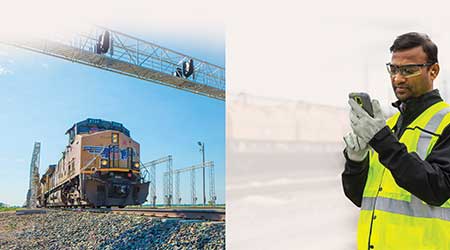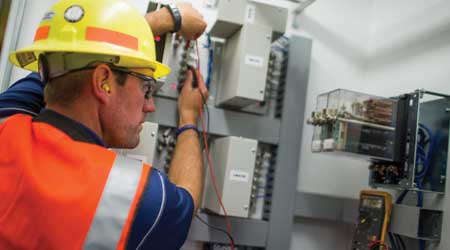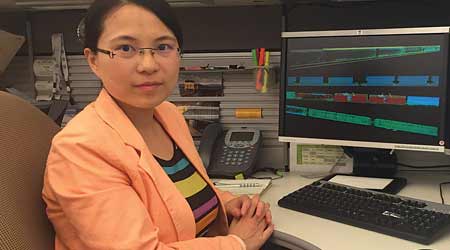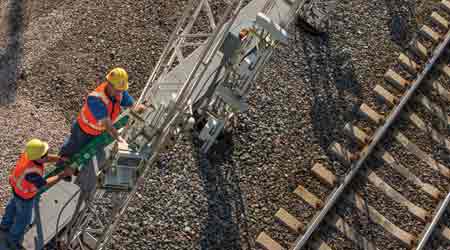Union Pacific continues to pursue technologies that can enhance safety, streamline operations
(Source: Progressive Railroading March 2018)

(At left) A UP train passes through a Machine Vision portal, which uses cameras, lasers and sensors to inspect cars electronically and detect any anomalies. (At right) UP Systems Engineer Shekar Madugundu played a role in developing a system that enables train engine and yard employees to use a modified mobile phone to report car movements in real time. Photo – Union Pacific Railroad
By Jeff Stagl, Managing Editor
Like all Class Is, Union Pacific Railroad is trying to boost productivity, increase efficiency, improve safety and enlarge its customer base. To help meet those objectives, the Class I continues to pursue something that’s also long been a common target for nearly all railroads large and small: technological advances.
Capitalizing on emerging software, applications, and electronic tools and processes is vital to achieving business growth and operational improvement goals, UP senior managers believe. To that end, the Class I strives to not only monitor, assess and adopt the latest technologies, but to devise and employ its own innovations.
The Class I now is a leader in developing and applying technologies to enhance safety, streamline operations and help customers grow, UP Chairman, President and Chief Executive Officer Lance Fritz believes. Yet, the company will need to continue pushing for “new discoveries” to help mold its future, he wrote in an email.
“Artificial intelligence and virtual reality are promising opportunities to improve safety and make it easier for customers to do business with us. The challenge is to keep up with technology’s accelerated pace,” Fritz wrote.
He cited drones as a pertinent example of trying to remain in step. UP has been using unmanned aerial vehicles (UAVs) the past few years to inspect bridges and observe the sites of derailments or hazardous materials incidents before first responders arrive.
Now, the Class I is testing drones to analyze their effectiveness in inspecting towers and track. In addition, an in-house team recently broadened UAV usage for bridge inspections by developing perspective navigation technology that enables drones to operate in areas not covered by GPS. The innovation could lead to autonomous UAVs.
“Our ability to fly drones was limited to areas with GPS coverage, impeding access under large metal bridges,” Fritz wrote.
Over the past five years, the railroad has been more aggressive in its pursuit of emerging technologies, ranging from software to applications to new computing processes, says Lynden Tennison, UP’s senior vice president and chief information officer. Among the newest and most promising: Big Data, predictive and video analytics, machine and deep learning, artificial intelligence and autonomous vehicles.
“We want to be an early adopter, to push the industry a bit,” says Tennison. “It’s all about ways to drive efficiencies and create better products for customers.”
Big on Big Data
When it comes to drawing benefits from improving analytics and managing Big Data — or the large volumes of information that can inundate a business each day — a new UP- developed sensor is beginning to boost safety and operational efficiency.

The Class I aims to continue addressing challenges posed by Big Data, such as finding better ways to capture, store, analyze and share large volumes of information. Union Pacific Railroad
Inserted in rail as a small plug, the quarter-sized sensor is designed to identify faulty rail-car components before they cause operational problems. The device features an accelerometer, digital temperature gauge and strain gauge.
Earlier this year, UP began deploying the sensor in a “sizable” Pacific Northwest territory, says Tennison.
The device gathers car measurements as a train passes, then computer algorithms analyze the data and search for any aberrations. Similar to a wheel impact load detector, it can determine wheel impact or a flat wheel, says Tennison.
“The sensor also can measure the weight of a car in transit,” he says. “We think we can eventually replace hot-box detectors on track.”
The sensor is a “huge” Big Data play, helping to make maintenance and repair activities more efficient, and ensure capacity is maximized, Tennison says.
The device also is a prime example of UP’s ability to research, develop and control its own technologies, he believes. Doing so can reduce information technology costs, produce royalty income if a developed product is marketed and boost recruitment efforts.
“Although we still rely on lots of vendors, we tend to lean toward developing technologies in house,” says Tennison.
In terms of ongoing R&D, UP continues to refine and expand the capability of Machine Vision.
A portal to analytics
Implemented a few years ago, Machine Vision is a trackside erector-set-like portal featuring cameras, lasers and sensors that electronically inspect cars on a passing train and identify any anomalies.
The trackside portals are designed to greatly reduce the time that would be necessary to perform manual train inspections.

Yujie Ying, a UP associate systems consultant, sits in front of a monitor showing several Machine Vision models that were created using the system’s lasers. Union Pacific Railroad
The railroad continues to employ Machine Vision systems near major yards in Stuttgart, Arkansas; North Platte, Nebraska; and Loveland, Iowa. The systems feature 10 cameras that capture images of cars’ sides, undersides and ends, and four light detection and ranging (LIDAR) units that generate 3-D, X-ray-type views of car components.
Machine Vision can help take video analytics and machine learning to a higher level, especially since the analytics software is “the beauty” of the system, Tennison says.
“We want to do some other things with the analytics. We have so much data, we can gain a small data center at trackside,” he says. “In three to six months, I think we will … figure out where to go from here [and] look at other applications in the company.”
‘Unguided learning’ curve
UP already has veered a bit from machine learning, a process through which a computer system uses data to determine how to progressively improve performance on a specific task without being explicitly programmed to do so.

Although UP has no plans at this time to install more Machine Vision portals, there could at some point be as many as 70 of them in its network if the Class I chooses to have the systems in place on all high-traffic mainlines. Union Pacific Railroad
The Class I now is doing more with deep learning, a process that involves computers and “unguided learning,” says Todd Snyder, UP’s senior manager of advanced freight-car engineering. Through unguided learning, a computer can decipher something while processing data without human guidance, he says.
For example, after Machine Vision produces a variety of images, a computer employing deep learning could classify all the photographed objects and issue an alert if it detects too many round objects. However, the circular objects might turn out to be the bearings since the computer continues to learn, says Snyder.
“Deep learning is the Big Data, cutting-edge thing,” he says.
To help support that process and other advanced computing techniques, UP has installed graphics processing units in all analytic sensors that feature hundreds of processors versus the couple found in most computers.
“We now have tools that are so sophisticated they can do data analysis, and humans come in after the fact,” says Snyder.
For now, employees continue to analyze photos and LIDAR images produced by Machine Vision. The images are compiled in seconds after a train passes, then are sent to a server that uses 23 algorithms to determine any anomalies that warrant an automated alert. Anomalies could include broken springs, thin brake shoes, a bent ladder, or a car component that’s too high, low or wide.
It typically takes an employee about an hour to review all images and process all automated alerts, but the goal is to reduce that time to a half hour, says Snyder. The aim is to use Machine Vision to find “the worst of the worst” problems, then rectify them as quickly as possible, he says.
Over time, UP plans to add cameras to the portals that, for example, could photograph the roofs of box cars, auto racks and other cars. For now, the railroad has added visual capabilities to help identify broken wheels and bad bearings, which are safety issues, says Snyder.
Although there are no current plans to install more Machine Vision systems, there could at some point be as many as 70 of the portals in the network if UP chooses to cover its high-traffic mainlines, he says.
Enhancing the customer experience
In addition to tapping technologies to make its own processes and tasks more efficient, UP is trying to devise more electronic and easier ways for customers to do business with the railroad.
As the Class I continues to enhance the customer experience — such as by improving shipment visibility — shippers will find that “rail can be more welcoming,” says UP EVP and Chief Marketing Officer Beth Whited.
To that end, the railroad later this year plans to launch a “smart” estimated time of arrival (ETA) application for its mobile work order system that would provide shippers a more precise location/tracking feature and a more accurate delivery time for their cargo. Using machine learning and predictive analytics, the smart ETA app will access the GPS signals issued by locomotives — through UP’s upcoming positive train control system — to locate shipments and determine arrival times.
The app will “get smarter” and adjust ETAs based on the historical data gathered, says Tennison. Such an app designed for people driving to work would tell them that there’s construction on the road ahead and it’ll take longer to get there, he says.
Smart ETAs will be more accurate than the current ETA system that relies on automatic equipment identification readers and car trip plans, says Whited.
“We will pilot it first with unit train shippers, then roll it out to more customers,” she says. “The goal is to eventually make it available to carload customers, as well.”
So far, the mobile work order system has benefited both customers and UP workers. Developed by the railroad in 2013, the system has eliminated extra time spent by train engine and yard employees to report data at the end of their shifts.
Workers now use a modified mobile phone to report car movements in real time; the Class I recently streamlined the real-time reporting function.
The system enables customers to more quickly locate and track their cars — thus eliminating emails and phone calls to the railroad — as well as order or release cars up until they arrive. The mobile devices support improved data accuracy and timeliness, and help shippers better manage their supply chains, UP executives say.
The Class I now is refining and piloting an advance arrival notifications app for the system. Customers can use it to learn they’re next in line to receive their freight, or that they won’t receive any service on a particular day and when they instead would obtain cars, says Whited.
Also in the development pipeline: an artificial intelligence app that would feature an automated voice to answer some simple questions customers pose by phone, such as if a certain shipment could be moved by UP between particular cities. The “chatbot” app — which won’t require any human involvement — will be tested in summer, says Whited.
A new start with startups
To help ensure it remains at the innovation forefront, UP late last year partnered with Plug and Play, a startup accelerator and innovation center in California. Plug and Play assists startups via a combination of seed money, mentoring and connections to large companies in relevant industries interested in investing in their ideas.
The Class I is an anchor partner in Plug and Play’s Supply Chain Innovation Platform. UP officials participate in pitches from startups and vote on the ones they believe could be impactful. The winning startups collaborate with the railroad on their projects.
UP so far has participated in Internet of Things and supply chain “verticals” that involve shipment visibility, machine learning, artificial intelligence and other key technological issues, says Whited.
The railroad is conducting pilot projects with several companies, including one that maintains a “massive” dataset on economic and consumer consumption indicators, she says. That firm is working with the railroad to create a forecast model for markets of interest.
“It can help us be better predictors,” says Whited.
UP also is exploring other potential tech partnerships, including membership in the Blockchain in Transport Alliance (BiTA) that BNSF Railway Co. joined in February.
A blockchain is a continuously growing list of records that are linked and secured using cryptography. The technology functions as a distributed ledger in which all members have access to all data in a particular blockchain.
BiTA has more than 200 freight transportation members who work jointly to develop blockchain standards for the logistics industry and entire supply chain. They aim to define the data in the freight transportation blockchain, how the data is formatted and structured, and in which cases the blockchain will be used.
Watching and waiting
UP is evaluating blockchain technology, but so far the use cases are unclear, says Tennison.
“We’re still in the loop on it and don’t want to miss something, but we’re taking a wait-and-see approach,” he says. “We’re talking to people about it and reading up on it.”
In the meantime, the Class I aims to keep charging ahead this year on several tech-embracing fronts, such as driving Machine Vision analytic initiatives, and instilling machine and deep learning practices throughout the organization.
UP also is trying to determine how to best exploit autonomous vehicles, which are emerging quickly in both rail and non-rail applications. One application could be a small autonomous vehicle that performs track inspections, says Tennison.
As with other innovations, it’s better to be an early adopter than a late-to-the-game user, he believes.
“Autonomous vehicles can be used for more than just operations,” says Tennison. “As they evolve, there will be more applicability.”
Email questions or comments to jeff.stagl@tradepress.com.
